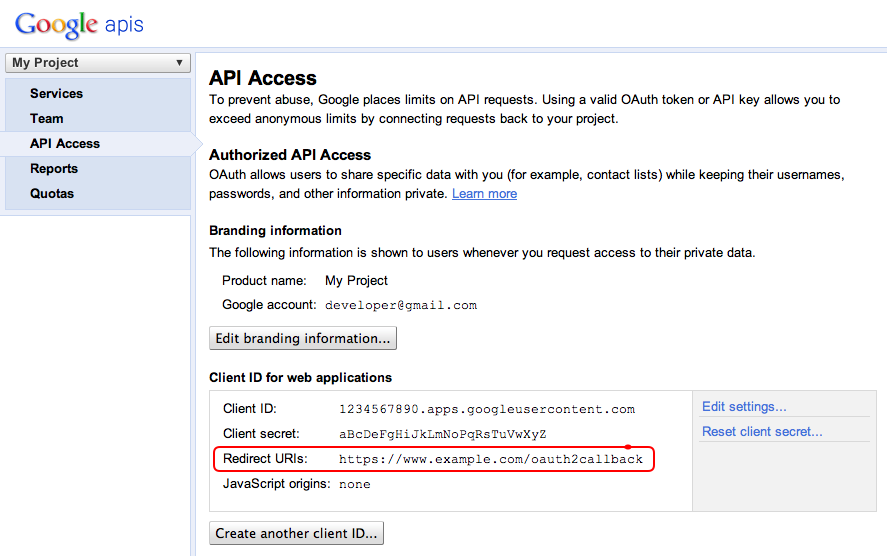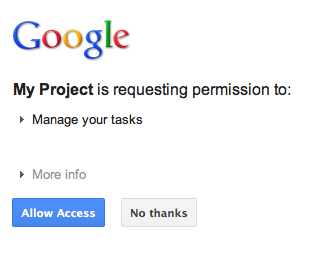このドキュメントでは、Google Tasks API を使用してユーザーのタスクを表示するサンプル ウェブ アプリケーションから、Java サーブレットを使用して OAuth 2.0 認証コールバック ハンドラを実装する方法について説明します。サンプル アプリケーションは、まずユーザーの Google ToDo リストへのアクセス承認をリクエストし、デフォルトのタスクリストにユーザーのタスクを表示します。
オーディエンス
このドキュメントは、Java と J2EE のウェブ アプリケーション アーキテクチャに精通しているユーザーを対象としています。OAuth 2.0 承認フローについてある程度の知識があることが推奨されます。
目次
サンプルを完全に機能させるには、いくつかのステップが必要です。
- web.xml ファイルでサーブレット マッピングを宣言する
- システム上でユーザーを認証し、そのタスクにアクセスするための承認をリクエストする
- Google の認可エンドポイントからの認可コードをリッスンする
- 認証コードを交換して更新トークンとアクセス トークンを取得する
- ユーザーのタスクの読み取りと表示
web.xml ファイルでサーブレット マッピングを宣言する
アプリケーションでは 2 つのサーブレットを使用します。
- PrintTasksTitlesServlet(/ にマッピング): ユーザー認証を処理し、ユーザーのタスクを表示するアプリケーションのエントリ ポイント。
- OAuthCodeCallbackHandlerServlet(/oauth2callback にマッピング): OAuth 認可エンドポイントからのレスポンスを処理する OAuth 2.0 コールバック
以下の web.xml ファイルでは、これら 2 つのサーブレットをアプリケーションの URL にマッピングしています。
<?xml version="1.0" encoding="UTF-8"?>
<web-app version="2.5" xmlns="http://java.sun.com/xml/ns/javaee"
xmlns:xsi="http://www.w3.org/2001/XMLSchema-instance"
xsi:schemaLocation="http://java.sun.com/xml/ns/javaee http://java.sun.com/xml/ns/javaee/web-app_2_5.xsd">
<servlet>
<servlet-name>PrintTasksTitles</servlet-name>
<servlet-class>com.google.oauthsample.PrintTasksTitlesServlet</servlet-class>
</servlet>
<servlet-mapping>
<servlet-name>PrintTasksTitles</servlet-name>
<url-pattern>/</url-pattern>
</servlet-mapping>
<servlet>
<servlet-name>OAuthCodeCallbackHandlerServlet</servlet-name>
<servlet-class>com.google.oauthsample.OAuthCodeCallbackHandlerServlet</servlet-class>
</servlet>
<servlet-mapping>
<servlet-name>OAuthCodeCallbackHandlerServlet</servlet-name>
<url-pattern>/oauth2callback</url-pattern>
</servlet-mapping>
</web-app>
システム上でユーザーを認証し、そのタスクにアクセスするための承認をリクエストする
ユーザーがルート「/」PrintTaskListsTitlesServlet サーブレットにマッピングされる URL。このサーブレットでは、次のタスクが実行されます。
- ユーザーがシステムで認証されているかどうかを確認する
- ユーザーが認証されていない場合は、認証ページにリダイレクトされます。
- ユーザーが認証された場合は、更新トークンがデータ ストレージにすでにあるかどうかを確認します。更新トークンは以下の OAuthTokenDao で処理されます。ユーザーが利用できる更新トークンがない場合は、ユーザーがまだアプリケーションにタスクへのアクセスを許可していないことを意味します。その場合、ユーザーは Google の OAuth 2.0 認可エンドポイントにリダイレクトされます。
package com.google.oauthsample;
import ...
/**
* Simple sample Servlet which will display the tasks in the default task list of the user.
*/
@SuppressWarnings("serial")
public class PrintTasksTitlesServlet extends HttpServlet {
/**
* The OAuth Token DAO implementation, used to persist the OAuth refresh token.
* Consider injecting it instead of using a static initialization. Also we are
* using a simple memory implementation as a mock. Change the implementation to
* using your database system.
*/
public static OAuthTokenDao oauthTokenDao = new OAuthTokenDaoMemoryImpl();
public void doGet(HttpServletRequest req, HttpServletResponse resp) throws IOException {
// Getting the current user
// This is using App Engine's User Service but you should replace this to
// your own user/login implementation
UserService userService = UserServiceFactory.getUserService();
User user = userService.getCurrentUser();
// If the user is not logged-in it is redirected to the login service, then back to this page
if (user == null) {
resp.sendRedirect(userService.createLoginURL(getFullRequestUrl(req)));
return;
}
// Checking if we already have tokens for this user in store
AccessTokenResponse accessTokenResponse = oauthTokenDao.getKeys(user.getEmail());
// If we don't have tokens for this user
if (accessTokenResponse == null) {
OAuthProperties oauthProperties = new OAuthProperties();
// Redirect to the Google OAuth 2.0 authorization endpoint
resp.sendRedirect(new GoogleAuthorizationRequestUrl(oauthProperties.getClientId(),
OAuthCodeCallbackHandlerServlet.getOAuthCodeCallbackHandlerUrl(req), oauthProperties
.getScopesAsString()).build());
return;
}
}
/**
* Construct the request's URL without the parameter part.
*
* @param req the HttpRequest object
* @return The constructed request's URL
*/
public static String getFullRequestUrl(HttpServletRequest req) {
String scheme = req.getScheme() + "://";
String serverName = req.getServerName();
String serverPort = (req.getServerPort() == 80) ? "" : ":" + req.getServerPort();
String contextPath = req.getContextPath();
String servletPath = req.getServletPath();
String pathInfo = (req.getPathInfo() == null) ? "" : req.getPathInfo();
String queryString = (req.getQueryString() == null) ? "" : "?" + req.getQueryString();
return scheme + serverName + serverPort + contextPath + servletPath + pathInfo + queryString;
}
}
注: 上記の実装では一部の App Engine ライブラリを使用していますが、簡略化のために使用されています。別のプラットフォーム向けに開発している場合は、ユーザー認証を処理する UserService インターフェースを再実装できます。
アプリケーションは DAO を使用してユーザーの認証トークンを保持し、アクセスします。以下は、このサンプルで使用されているインターフェース OAuthTokenDao とモック(メモリ内)実装 OAuthTokenDaoMemoryImpl です。
package com.google.oauthsample;
import com.google.api.client.auth.oauth2.draft10.AccessTokenResponse;
/**
* Allows easy storage and access of authorization tokens.
*/
public interface OAuthTokenDao {
/**
* Stores the given AccessTokenResponse using the {@code username}, the OAuth
* {@code clientID} and the tokens scopes as keys.
*
* @param tokens The AccessTokenResponse to store
* @param userName The userName associated wit the token
*/
public void saveKeys(AccessTokenResponse tokens, String userName);
/**
* Returns the AccessTokenResponse stored for the given username, clientId and
* scopes. Returns {@code null} if there is no AccessTokenResponse for this
* user and scopes.
*
* @param userName The username of which to get the stored AccessTokenResponse
* @return The AccessTokenResponse of the given username
*/
public AccessTokenResponse getKeys(String userName);
}
package com.google.oauthsample;
import com.google.api.client.auth.oauth2.draft10.AccessTokenResponse;
...
/**
* Quick and Dirty memory implementation of {@link OAuthTokenDao} based on
* HashMaps.
*/
public class OAuthTokenDaoMemoryImpl implements OAuthTokenDao {
/** Object where all the Tokens will be stored */
private static Map
また、アプリケーションの OAuth 2.0 認証情報はプロパティ ファイルに格納されています。または、Java クラスのどこかで定数として指定することもできますが、サンプルで使用されている OAuthProperties クラスと oauth.properties ファイルを以下に示します。
package com.google.oauthsample;
import ...
/**
* Object representation of an OAuth properties file.
*/
public class OAuthProperties {
public static final String DEFAULT_OAUTH_PROPERTIES_FILE_NAME = "oauth.properties";
/** The OAuth 2.0 Client ID */
private String clientId;
/** The OAuth 2.0 Client Secret */
private String clientSecret;
/** The Google APIs scopes to access */
private String scopes;
/**
* Instantiates a new OauthProperties object reading its values from the
* {@code OAUTH_PROPERTIES_FILE_NAME} properties file.
*
* @throws IOException IF there is an issue reading the {@code propertiesFile}
* @throws OauthPropertiesFormatException If the given {@code propertiesFile}
* is not of the right format (does not contains the keys {@code
* clientId}, {@code clientSecret} and {@code scopes})
*/
public OAuthProperties() throws IOException {
this(OAuthProperties.class.getResourceAsStream(DEFAULT_OAUTH_PROPERTIES_FILE_NAME));
}
/**
* Instantiates a new OauthProperties object reading its values from the given
* properties file.
*
* @param propertiesFile the InputStream to read an OAuth Properties file. The
* file should contain the keys {@code clientId}, {@code
* clientSecret} and {@code scopes}
* @throws IOException IF there is an issue reading the {@code propertiesFile}
* @throws OAuthPropertiesFormatException If the given {@code propertiesFile}
* is not of the right format (does not contains the keys {@code
* clientId}, {@code clientSecret} and {@code scopes})
*/
public OAuthProperties(InputStream propertiesFile) throws IOException {
Properties oauthProperties = new Properties();
oauthProperties.load(propertiesFile);
clientId = oauthProperties.getProperty("clientId");
clientSecret = oauthProperties.getProperty("clientSecret");
scopes = oauthProperties.getProperty("scopes");
if ((clientId == null) || (clientSecret == null) || (scopes == null)) {
throw new OAuthPropertiesFormatException();
}
}
/**
* @return the clientId
*/
public String getClientId() {
return clientId;
}
/**
* @return the clientSecret
*/
public String getClientSecret() {
return clientSecret;
}
/**
* @return the scopes
*/
public String getScopesAsString() {
return scopes;
}
/**
* Thrown when the OAuth properties file was not at the right format, i.e not
* having the right properties names.
*/
@SuppressWarnings("serial")
public class OAuthPropertiesFormatException extends RuntimeException {
}
}
以下の oauth.properties ファイルです。このファイルには、アプリケーションの OAuth 2.0 認証情報が含まれています。以下の値はご自身で変更する必要があります。
# Client ID and secret. They can be found in the APIs console.
clientId=1234567890.apps.googleusercontent.com
clientSecret=aBcDeFgHiJkLmNoPqRsTuVwXyZ
# API scopes. Space separated.
scopes=https://www.googleapis.com/auth/tasks
OAuth 2.0 クライアント ID とクライアント シークレットによってアプリケーションが識別され、アプリケーション用に定義されたフィルタと割り当てルールを Tasks API が適用できるようになります。クライアント ID とシークレットは Google API コンソールで確認できます。コンソールで以下を行う必要があります。
- プロジェクトを作成または選択します。
- サービスのリストで Tasks API のステータスを [オン] に切り替えて、Tasks API を有効にします。
- [API Access] で OAuth 2.0 クライアント ID を作成します(まだ作成していない場合)。
- プロジェクトの OAuth 2.0 コード コールバック ハンドラの URL がリダイレクト URI で登録またはホワイトリストに登録されていることを確認します。たとえば、このサンプル プロジェクトでは、ウェブ アプリケーションが https://www.example.com ドメインから提供される場合、https://www.example.com/oauth2callback を登録する必要があります。

Google の認可エンドポイントからの認可コードをリッスンする
ユーザーがまだアプリケーションによるタスクへのアクセスを承認しておらず、そのため Google の OAuth 2.0 認可エンドポイントにリダイレクトされている場合、アプリケーションにタスクへのアクセスを許可するよう求める Google からの承認ダイアログがユーザーに表示されます。

アクセスを許可または拒否すると、ユーザーは OAuth 2.0 コードのコールバック ハンドラにリダイレクトされます。このハンドラは、Google 認証 URL の作成時にリダイレクト/コールバックとして指定されています。
new GoogleAuthorizationRequestUrl(oauthProperties.getClientId(),
OAuthCodeCallbackHandlerServlet.getOAuthCodeCallbackHandlerUrl(req), oauthProperties
.getScopesAsString()).build()
OAuth 2.0 コードのコールバック ハンドラ(OAuthCodeCallbackHandlerServlet)は、Google OAuth 2.0 エンドポイントからのリダイレクトを処理します。次の 2 つのケースを処理します。
- ユーザーがアクセスを許可した場合: リクエストを解析して URL パラメータから OAuth 2.0 コードを取得します
- ユーザーがアクセスを拒否した: ユーザーにメッセージが表示されます。
package com.google.oauthsample;
import ...
/**
* Servlet handling the OAuth callback from the authentication service. We are
* retrieving the OAuth code, then exchanging it for a refresh and an access
* token and saving it.
*/
@SuppressWarnings("serial")
public class OAuthCodeCallbackHandlerServlet extends HttpServlet {
/** The name of the Oauth code URL parameter */
public static final String CODE_URL_PARAM_NAME = "code";
/** The name of the OAuth error URL parameter */
public static final String ERROR_URL_PARAM_NAME = "error";
/** The URL suffix of the servlet */
public static final String URL_MAPPING = "/oauth2callback";
public void doGet(HttpServletRequest req, HttpServletResponse resp) throws IOException {
// Getting the "error" URL parameter
String[] error = req.getParameterValues(ERROR_URL_PARAM_NAME);
// Checking if there was an error such as the user denied access
if (error != null && error.length > 0) {
resp.sendError(HttpServletResponse.SC_NOT_ACCEPTABLE, "There was an error: \""+error[0]+"\".");
return;
}
// Getting the "code" URL parameter
String[] code = req.getParameterValues(CODE_URL_PARAM_NAME);
// Checking conditions on the "code" URL parameter
if (code == null || code.length == 0) {
resp.sendError(HttpServletResponse.SC_BAD_REQUEST, "The \"code\" URL parameter is missing");
return;
}
}
/**
* Construct the OAuth code callback handler URL.
*
* @param req the HttpRequest object
* @return The constructed request's URL
*/
public static String getOAuthCodeCallbackHandlerUrl(HttpServletRequest req) {
String scheme = req.getScheme() + "://";
String serverName = req.getServerName();
String serverPort = (req.getServerPort() == 80) ? "" : ":" + req.getServerPort();
String contextPath = req.getContextPath();
String servletPath = URL_MAPPING;
String pathInfo = (req.getPathInfo() == null) ? "" : req.getPathInfo();
return scheme + serverName + serverPort + contextPath + servletPath + pathInfo;
}
}
認証コードを更新トークンとアクセス トークンに交換する
次に、OAuthCodeCallbackHandlerServlet は、Auth 2.0 コードをリフレッシュ トークンとアクセス トークンと交換し、それをデータストアに保持して、ユーザーを PrintTaskListsTitlesServlet URL にリダイレクトします。
以下のファイルに追加されたコードは構文がハイライト表示され、既存のコードはグレー表示になっています。
/** コールバック処理後にユーザーをリダイレクトする URL。検討事項
* ユーザーを Google にリダイレクトする前に Cookie に保存する
* ユーザーのリダイレクト先となる URL が複数ある場合は承認 URL。*/
public static final String REDIRECT_URL = "/";
/** OAuth トークン DAO 実装。代わりに挿入することを検討する
* 静的初期化です。また、シンプルなメモリ実装を使用して、
* 使用できます。データベース システムを使用するように実装を変更します。*/
public static OAuthTokenDao oauthTokenDao = new OAuthTokenDaoMemoryImpl();
// 受信リクエストの URL を作成する
String requestUrl = getOAuthCodeCallbackHandlerUrl(req);
// OAuth トークンのコードを交換
AccessTokenResponse accessTokenResponse = ExchangeCodeForAccessAndRefreshTokens(code[0],
requestUrl);
// 現在のユーザーを取得する
// これは App Engine のユーザー サービスを使用していますが、これを
// 独自のユーザー/ログイン実装
UserService userService = UserServiceFactory.getUserService();
String email = userService.getCurrentUser().getEmail();
// トークンを保存する
oauthTokenDao.saveKeys(accessTokenResponse, email);
resp.sendRedirect(REDIRECT_URL);
}
/**
* 指定されたコードをエクスチェンジと更新トークンと交換します。
*
* @param code 認可サービスから返されたコード
* @param currentUrl コールバックの URL
* @param oauthProperties OAuth 構成を含むオブジェクト
* @return アクセス トークンと更新トークンの両方を含むオブジェクト
* @IOException をスロー
*/
public AccessTokenResponse ExchangeCodeForAccessAndRefreshTokens(String code, String currentUrl)
throws IOException {
HttpTransport httpTransport = new NetHttpTransport();
JacksonFactory jsonFactory = new JacksonFactory();
// OAuth 構成ファイルの読み込み
OAuthProperties oauthProperties = new OAuthProperties();
新しい GoogleAuthorizationCodeGrant(httpTransport, jsonFactory, oauthProperties) が返される
.getClientId()、oauthProperties.getClientSecret()、コード、currentUrl).execute();
}
}OAuthCodeCallbackHandlerServlet.java ファイル注: 上記の実装では一部の App Engine ライブラリを使用していますが、簡略化のために使用されています。別のプラットフォーム向けに開発している場合は、ユーザー認証を処理する UserService インターフェースを再実装できます。
ユーザーのタスクを読み取って表示する
ユーザーがアプリケーションにタスクへのアクセスを許可しました。アプリケーションの更新トークンはデータストアに保存され、OAuthTokenDao を使用してアクセスできます。これで、PrintTaskListsTitlesServlet サーブレットがこれらのトークンを使用してユーザーのタスクにアクセスし、タスクを表示できるようになりました。
以下のファイルに追加されたコードは構文がハイライト表示され、既存のコードはグレー表示になっています。
